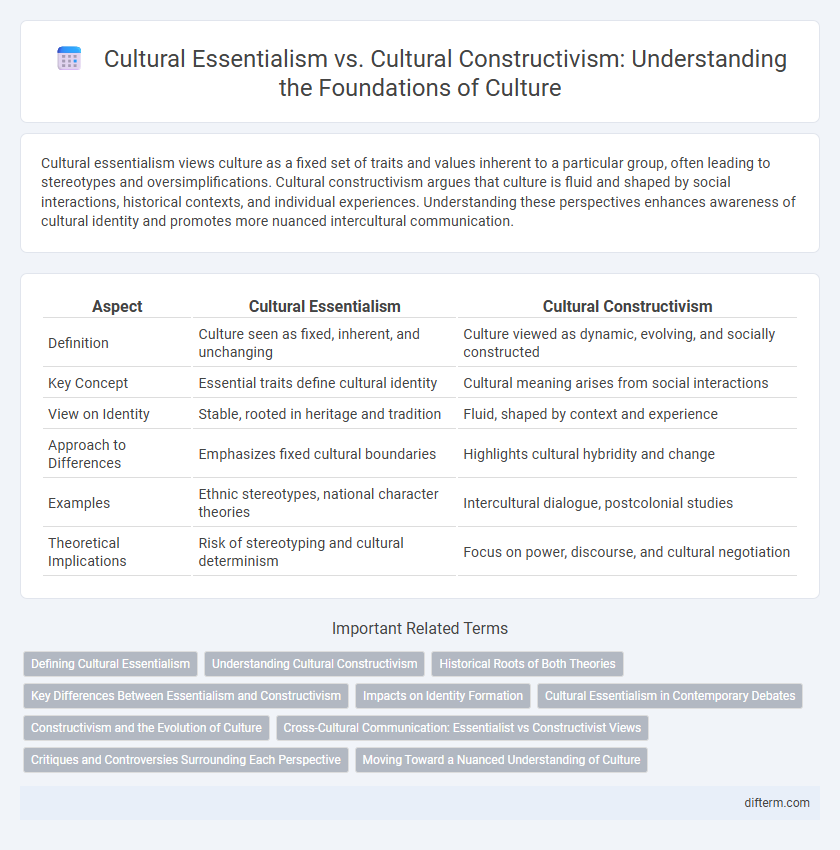Cultural essentialism views culture as a fixed set of traits and values inherent to a particular group, often leading to stereotypes and oversimplifications. Cultural constructivism argues that culture is fluid and shaped by social interactions, historical contexts, and individual experiences. Understanding these perspectives enhances awareness of cultural identity and promotes more nuanced intercultural communication.
Table of Comparison
| Aspect | Cultural Essentialism | Cultural Constructivism |
|---|---|---|
| Definition | Culture seen as fixed, inherent, and unchanging | Culture viewed as dynamic, evolving, and socially constructed |
| Key Concept | Essential traits define cultural identity | Cultural meaning arises from social interactions |
| View on Identity | Stable, rooted in heritage and tradition | Fluid, shaped by context and experience |
| Approach to Differences | Emphasizes fixed cultural boundaries | Highlights cultural hybridity and change |
| Examples | Ethnic stereotypes, national character theories | Intercultural dialogue, postcolonial studies |
| Theoretical Implications | Risk of stereotyping and cultural determinism | Focus on power, discourse, and cultural negotiation |
Defining Cultural Essentialism
Cultural essentialism asserts that distinct cultures possess inherent, unchanging attributes defining their identity, often emphasizing fixed traits such as language, traditions, and values. This perspective views culture as a stable, core essence passed through generations, shaping collective behavior and social norms. Critics argue essentialism overlooks cultural fluidity and the dynamic interactions influencing cultural evolution.
Understanding Cultural Constructivism
Cultural constructivism emphasizes that culture is not a fixed set of traits but a dynamic process shaped by social interactions and historical contexts. It argues that cultural meanings and identities are continuously constructed and reconstructed through communication and collective experiences. This perspective challenges essentialist views by highlighting the fluidity and diversity within cultures, acknowledging power relations in cultural production.
Historical Roots of Both Theories
Cultural essentialism traces its historical roots to early anthropological and nationalist thought, emphasizing innate, unchanging cultural traits passed through generations. In contrast, cultural constructivism emerged from mid-20th-century social theory, highlighting culture as a dynamic, socially constructed phenomenon shaped by historical and political contexts. These divergent origins reflect fundamental debates on whether culture is a fixed essence or an evolving social product.
Key Differences Between Essentialism and Constructivism
Cultural essentialism asserts that cultural traits and identities are fixed, innate, and inherent to particular groups, emphasizing unchanging characteristics passed through generations. In contrast, cultural constructivism views culture as dynamic and fluid, shaped by social interactions, historical contexts, and individual experiences that continuously redefine cultural meaning. The key difference lies in essentialism's focus on static cultural essences versus constructivism's emphasis on culture as a socially constructed and evolving phenomenon.
Impacts on Identity Formation
Cultural essentialism posits that identities are rooted in fixed, inherent cultural traits, influencing individuals to perceive themselves through inherited traditions and collective memory. In contrast, cultural constructivism argues that identity is fluid and shaped through social interactions, experiences, and evolving cultural narratives. These differing perspectives impact identity formation by either reinforcing static group boundaries or promoting dynamic, hybrid identities adaptable to changing social contexts.
Cultural Essentialism in Contemporary Debates
Cultural essentialism asserts that specific cultural traits and identities are innate, stable, and defining characteristics of particular groups, shaping social behaviors and worldviews. In contemporary debates, this perspective faces criticism for oversimplifying cultural diversity and reinforcing stereotypes, yet it remains influential in discussions about cultural preservation and minority rights. The essentialist view often clashes with cultural constructivism, which argues that culture is fluid, dynamic, and shaped by social interactions and historical contexts.
Constructivism and the Evolution of Culture
Cultural Constructivism posits that culture evolves through ongoing social interactions and shared meanings rather than fixed traits or inherent characteristics. This perspective emphasizes the dynamic process where individuals and groups continuously negotiate and reinterpret cultural norms, leading to cultural transformations over time. By viewing culture as fluid and context-dependent, Constructivism highlights the adaptability and innovation inherent in cultural evolution.
Cross-Cultural Communication: Essentialist vs Constructivist Views
Essentialist views in cross-cultural communication emphasize fixed, inherent traits defining cultural identities, often leading to generalized assumptions about behavior and values. Constructivist perspectives argue culture is dynamic and socially constructed through interaction, highlighting the variability and situational interpretation of cultural norms. Understanding these contrasting frameworks improves intercultural dialogue by balancing respect for cultural patterns with recognition of individual and contextual differences.
Critiques and Controversies Surrounding Each Perspective
Cultural essentialism faces criticism for promoting stereotypes by attributing fixed traits to entire groups, which can reinforce exclusion and ignore individual diversity. Cultural constructivism is challenged for potentially overlooking the influence of enduring cultural elements by emphasizing social construction to the point of relativism. Both perspectives spark controversies regarding identity politics, representation, and the balance between cultural heritage and social change.
Moving Toward a Nuanced Understanding of Culture
Cultural essentialism views culture as a fixed set of traits inherent to specific groups, while cultural constructivism argues that culture is dynamic and continuously shaped through social interactions and historical contexts. Moving toward a nuanced understanding involves recognizing the fluidity of cultural identities and the influence of power relations, migration, and globalization on cultural expressions. This perspective encourages examining culture as a complex, evolving process rather than a static or monolithic entity.
Cultural Essentialism vs Cultural Constructivism Infographic

 difterm.com
difterm.com